Universe Sandbox Roadmap: 2024 & Beyond

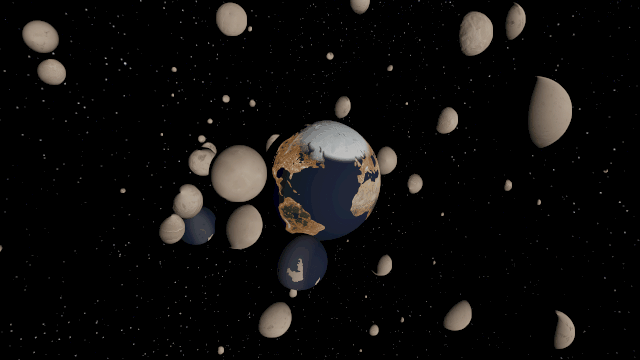
This year’s plans include a major graphics overhaul, more realistic collisions & craters, and putting Universe Sandbox on mobile devices so you can create and destroy on the go. Before getting into the details, here’s a brief recap of last year.
Highlights from 2023
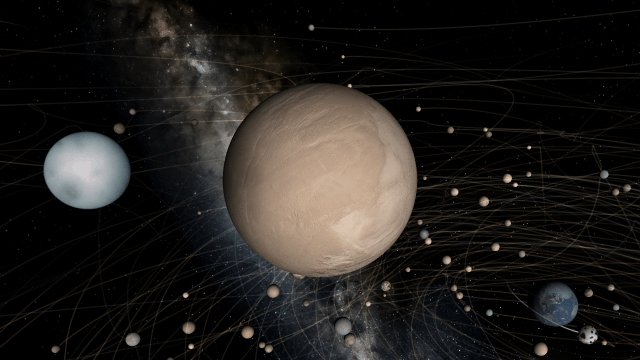
In 2023, we put out 4 feature-packed updates. Some of our favorite new additions include
- Massive improvements to our gravity simulation’s accuracy, stability, and performance.
- Adding 8 new materials, including oxygen & carbon dioxide, to realistically simulate, construct, and terraform planets and atmospheres.
- Rolling a Spherical Cow into Universe Sandbox. This refers to a joke that physicists sometimes oversimplify real-world problems to make them easier to solve.
The gravity simulation improvements and additional materials were major milestones from our 2023 Roadmap post. Check out our 2023 Retrospective post for more on what we did last year.
What’s the Plan for 2024?
- Using a new graphics renderer to immerse you further in the universe with bright glows, smoothly drifting dust clouds, and more.
- Optimizing our simulation performance with Unity’s Data-Oriented Technology Stack (DOTS).
- Doubling down on our efforts to bring Universe Sandbox to phones and tablets (iOS & Android).
- Begin adding basic plant-based life simulation.
- Continue improving our development tools to find and fix issues quickly.
We plan to work on all of these projects in 2024, but some, like our new graphics renderer, have been in the works for a while. Additional challenges may arise that delay features, and our priorities may change.
New Graphics: A Visual Glow-Up
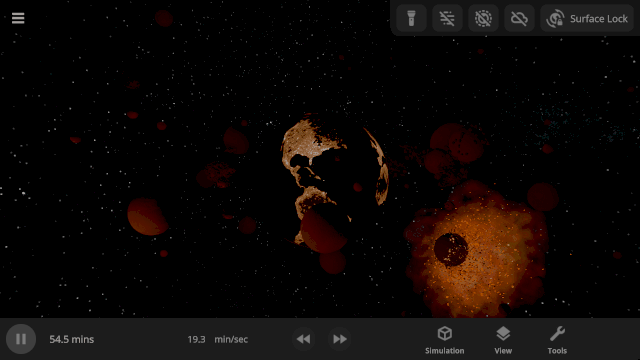
It’s time for a glow-up, literally. We’re rebuilding our graphics rendering from the ground up. After our overhaul, only the hot parts of the objects will glow instead of the entire object, dust clouds will blend smoothly with other objects, and more.
- New Graphics Renderer
- Last year, we started transitioning our graphics rendering to Unity’s Universal Render Pipeline (URP). This system allows us to use more true-to-life light properties and easily add and maintain new graphical elements. We’re expecting a performance boost too.
- Dust clouds passing through planets currently show sharp lines at their intersection. URP will let us render transparent clouds that blend smoothly with planets, called soft particles.
- Last year, we started transitioning our graphics rendering to Unity’s Universal Render Pipeline (URP). This system allows us to use more true-to-life light properties and easily add and maintain new graphical elements. We’re expecting a performance boost too.
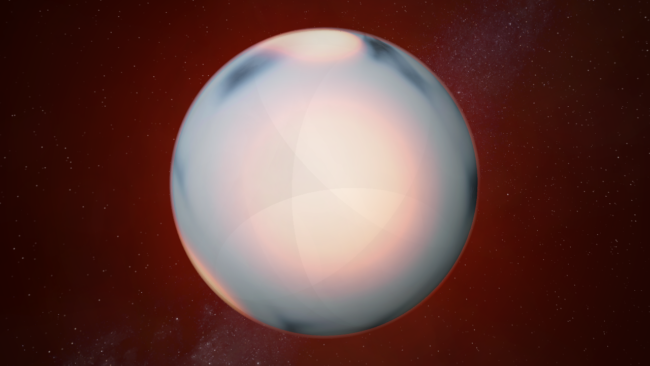
- Planets will glow only where their surfaces are hot, with hot spots from lasers and colliding objects only glowing at the impact site. Currently, planets glow uniformly based on their average temperature.
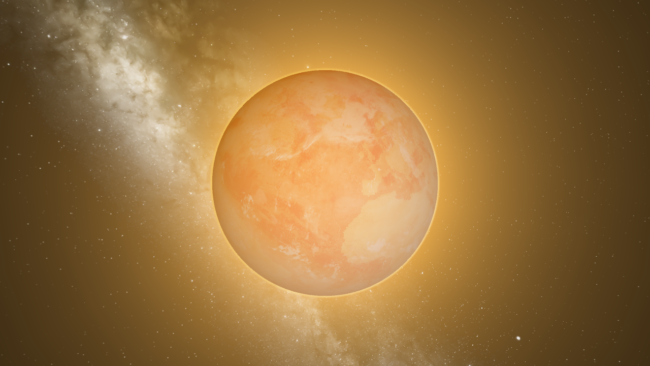
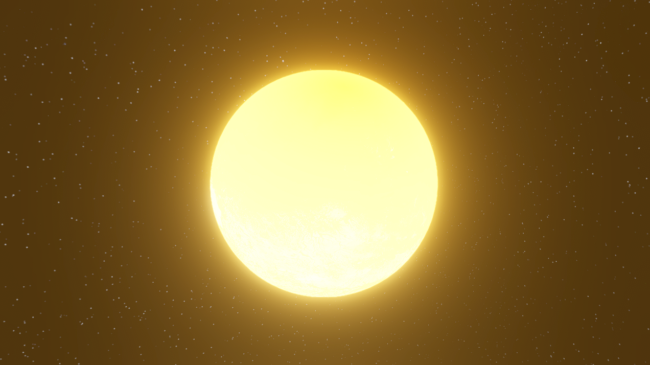
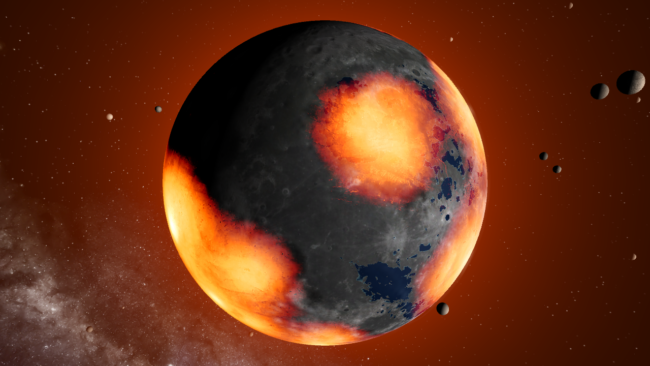
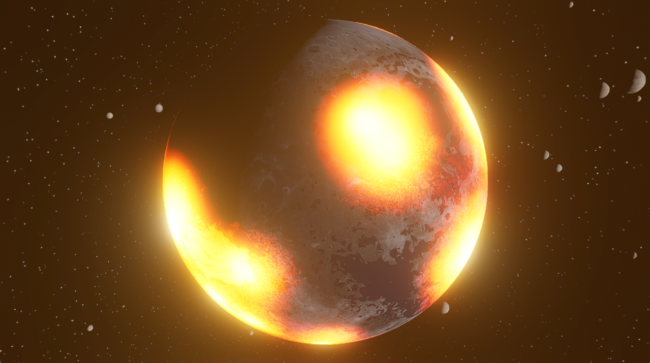
- Eventually, we’ll simulate objects casting shadows on themselves, like the solar panels on a spacecraft casting a shadow on its body.
- Lighting Up Space
- Light – it’s not just for stars anymore. Hot planets will emit light based on their temperature so you can light up your simulation with intense impacts.
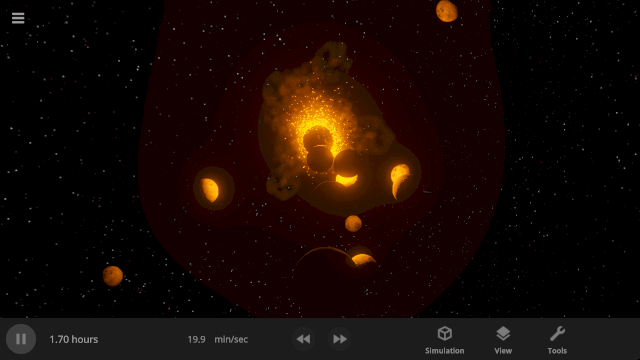
Physics: Collisions, Gravity, & Performance (Oh My)
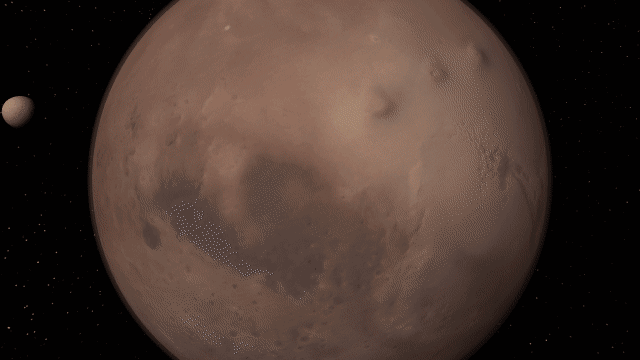
Improving collisions and their aftermath, like impact craters and ejecta, and continuing to optimize our physics simulation are all improvements we’re working on this year.
- Advanced Game Engine Features
- We’re continuing to reconstruct our simulation architecture using the Data-Oriented Technology Stack (DOTS) from Unity, the game engine we use to build Universe Sandbox. We made good progress last year and are excited about the expected performance gains.
- DOTS optimizes our simulation by efficiently running more computations simultaneously on the CPU, which means simulating more objects, collisions, and fragments at once.
- This transition will effectively combine parts of our simulation, like how different types of objects are defined, making it easier to maintain without sacrificing complexity.
- We’re continuing to reconstruct our simulation architecture using the Data-Oriented Technology Stack (DOTS) from Unity, the game engine we use to build Universe Sandbox. We made good progress last year and are excited about the expected performance gains.
- Grinding to a Halt
- Our new friction model will simulate craters stretching out as objects skid across each other’s surfaces during collisions. In our current simplistic model, craters are always circular.
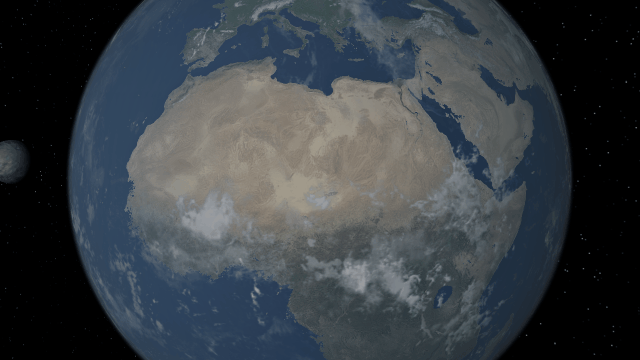
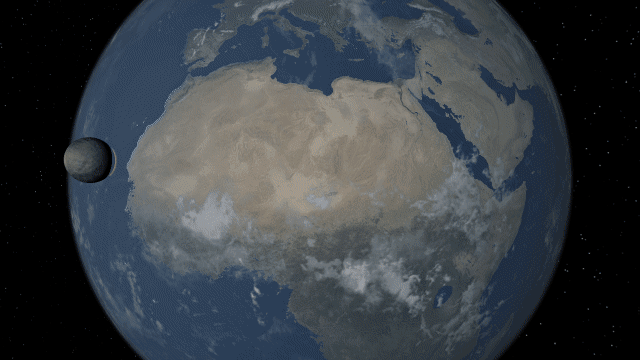
- To simulate meteors, we’re working on adding a drag force so objects burn up while traveling through a planet’s atmosphere. We’re also exploring ways to apply this force to objects passing through gas clouds and liquids. Currently, objects pass through atmospheres unchanged.
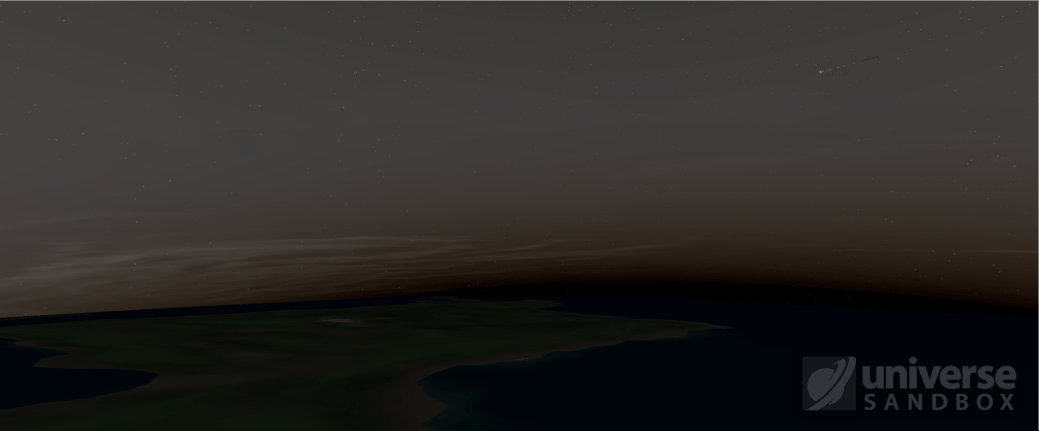
- Chaotic Consequences
- Rock fragments and gas clouds are created when planets collide or are vaporized, but computer limitations mean we sometimes need to remove the old ones to create new ones. We’re testing better removal methods to immerse you in the chaos. This was released in March as part of Update 34.1.
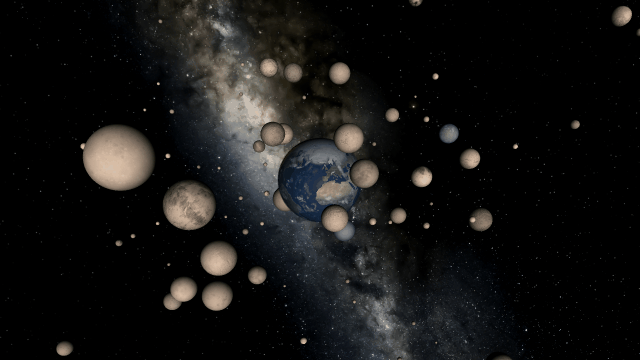
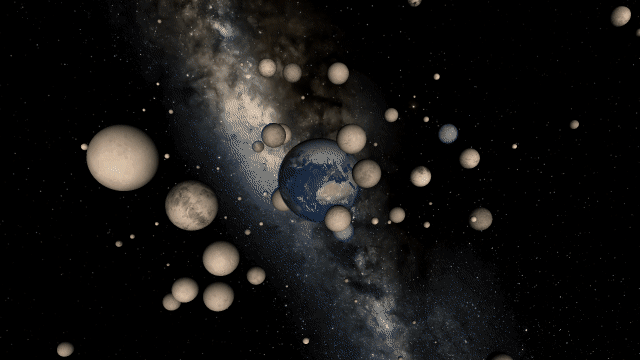
- New Gravity Simulation
- We’re experimenting with a new method of gravity simulation to allow rock fragments and dust clouds to attract and merge, forming planets & moons. Currently, these particles can only be pulled on and cannot form planets independently.
- We’re experimenting with a new method of gravity simulation to allow rock fragments and dust clouds to attract and merge, forming planets & moons. Currently, these particles can only be pulled on and cannot form planets independently.
- Smooth Object Transitions
- If the Sun gets too massive in Universe Sandbox, it instantly shrinks into a black hole. In real life, this shrinking and compression takes time. We’re updating our simulation so these transitions can occur on realistic timescales.
- We hope to simulate the answer to the question, “What if you filled the Solar System with soup out to Jupiter?” (Spoiler: The soup would contract into a supermassive black hole in about 30 minutes.)
- If the Sun gets too massive in Universe Sandbox, it instantly shrinks into a black hole. In real life, this shrinking and compression takes time. We’re updating our simulation so these transitions can occur on realistic timescales.
Universe Sandbox on Phones & Tablets
Getting Universe Sandbox on mobile devices (iOS & Android) is a major focus. We’re continuing to optimize our interface for small touch screens, and you can read about the latest mobile developments in our second Mobile DevLog.
- Small Screen Interface
- Unity’s cross-platform capabilities let us easily bring the same simulation changes to mobile devices and desktops.
- Our biggest challenge with mobile development is adapting our interface to work well on small touch screens (like a phone). Development is underway to intelligently resize, hide, and reveal panels as needed so you can focus on cosmic creation instead of managing the user interface.
- Unity’s cross-platform capabilities let us easily bring the same simulation changes to mobile devices and desktops.
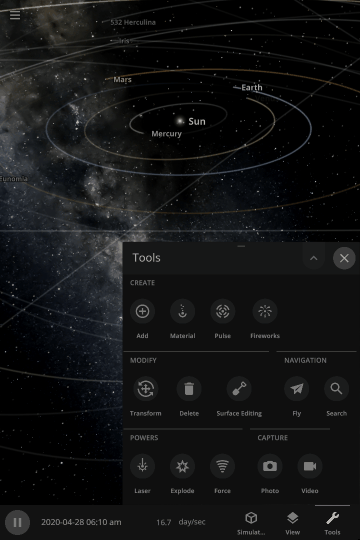
- Running a Universe
- Another requirement for mobile is boosting performance across all platforms. Alongside our new graphics renderer and rebuilding our simulation architecture, we’re improving interface responsiveness and resource utilization and optimizing start-up times, among other things.
- Another requirement for mobile is boosting performance across all platforms. Alongside our new graphics renderer and rebuilding our simulation architecture, we’re improving interface responsiveness and resource utilization and optimizing start-up times, among other things.
- More Information
- Universe Sandbox on mobile is built from the same codebase as the desktop version and will have the same features.
- There is no mobile release date yet.
- We plan on it being a one-time paid app with no ads or in-game purchases.
- Price is not finalized.
- Minimum requirements are not finalized.
- Sign up for our mobile mailing list to receive updates about mobile development
http://universesandbox.com/mobile/
Surface Simulation: Let There Be Life
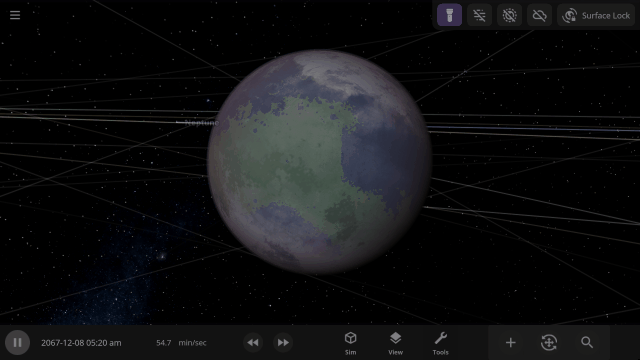
Now that we’re simulating materials like oxygen and carbon dioxide on planet surfaces, we can begin working on basic life simulation. Life will grow (and die) on these surfaces in real-time, the same way we simulate temperature, liquids, and gasses flowing.
- Basic Beginnings
- Initially, we plan to simulate just plant life, with vegetation growing, spreading, and dying based on the planet’s temperature, atmosphere pressure and composition, and more.
- As life develops, we’ll simulate how it affects the oxygen and carbon dioxide in the atmosphere, also known as a biosignature.
- Initially, we plan to simulate just plant life, with vegetation growing, spreading, and dying based on the planet’s temperature, atmosphere pressure and composition, and more.
- An Evolving Model
- Long term, we plan to add more varieties of life, like herbivores and carnivores, and simulate their interactions as a food chain develops.
- Eventually, you’ll be able to cause catastrophic events leading to mass extinctions and customize life conditions, like the amount of oxygen required for life to develop.
- Life will spread across planets’ surfaces after being Planetscaped onto a planet or appearing spontaneously. It will even spread to other planets on fragments from collisions.
- Long term, we plan to add more varieties of life, like herbivores and carnivores, and simulate their interactions as a food chain develops.
Upgrading Our Developer Toolkit
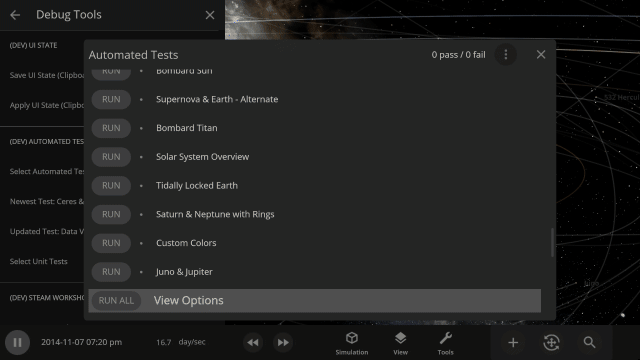
We’ve also been improving the tools we use to create and test Universe Sandbox for faster updates and bug fixing.
- Parallel Sandbox Construction
- Our newest automatic build system, which creates a new version of Universe Sandbox in the cloud whenever one of our team members changes the code, can make up to 10 versions at once.
- When many of us are making changes, this automation lets us test any new version within 30 minutes.
- When many of us are making changes, this automation lets us test any new version within 30 minutes.
- Each store that sells Universe Sandbox has slightly different requirements, so making multiple versions at once lets us release new updates almost simultaneously to all stores, like Steam and Epic. This process previously took a few hours.
- This new system will also create and deploy Universe Sandbox to mobile devices for testing on phones and tablets (iOS and Android).
- Our newest automatic build system, which creates a new version of Universe Sandbox in the cloud whenever one of our team members changes the code, can make up to 10 versions at once.

- Automation
- Expanding our automated test suite, which covers collision physics, simulation performance, and more, helps us catch and fix bugs faster.
- We’re exploring programmatic ways to compare test results to accelerate issue identification.
- We’re exploring programmatic ways to compare test results to accelerate issue identification.
- Producing and capturing game trailers and screenshots entirely in-game with a single button lets us easily show off the latest developments, like our upcoming new graphics renderer. New screenshots generated this way are already on our Steam store page, and we’re planning to release our updated trailer as an in-game guide.
- Expanding our automated test suite, which covers collision physics, simulation performance, and more, helps us catch and fix bugs faster.
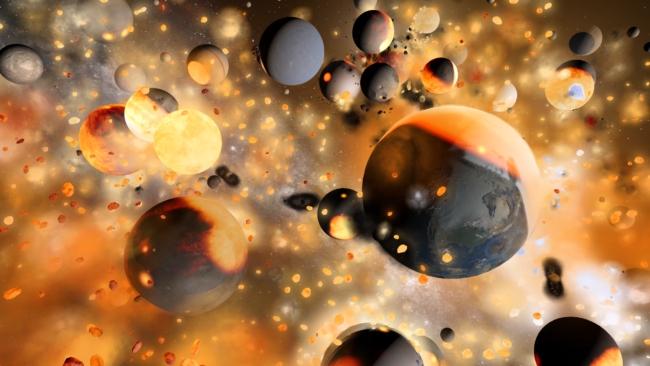
Updating Our Minimum Requirements
To adopt the latest technologies needed to restructure our simulation architecture and use our new graphics renderer, we plan to update our minimum requirements this year to include
- 4 GB dedicated video memory (up from 2 GB). 8 GB will be recommended.
- Apple: Silicon CPU (M1 or newer), meaning that Intel Mac will no longer be supported.
- Windows: Direct X version 12
While it is never fun to have support dropped, these new technologies will allow us to improve performance and add new features to Universe Sandbox now and well into the future.
We’ll ensure all users affected by this change can always access the version of Universe Sandbox from before this minimum requirements update.
And Beyond
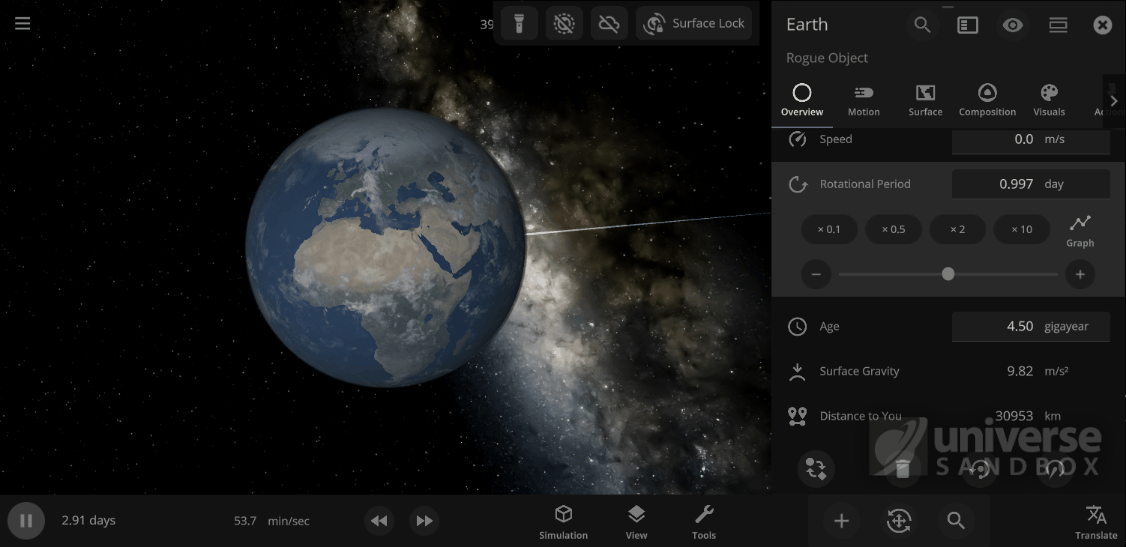
Our future goals include realistically colliding everyday objects, like a watermelon and a sledgehammer, adding detailed planet surfaces, and properly simulating comet tails. These are in early development, and we don’t know when they will be released.
- Stretch it Out
- Most objects in Universe Sandbox are spheres, but in real life, some rotate so quickly that they stretch and flatten, like the dwarf planet Haumea. We’re working to simulate that stretching.
- Most objects in Universe Sandbox are spheres, but in real life, some rotate so quickly that they stretch and flatten, like the dwarf planet Haumea. We’re working to simulate that stretching.
- Everyday Object Collisions
- Currently, when objects collide, they’re treated as spheres. We’re working on adding new physics so that everyday objects, including simple shapes like dice and complex shapes like spacecraft, will collide according to their unique forms. This is often known as rigid body collision physics.
- Currently, when objects collide, they’re treated as spheres. We’re working on adding new physics so that everyday objects, including simple shapes like dice and complex shapes like spacecraft, will collide according to their unique forms. This is often known as rigid body collision physics.
- Detailed Planet Surfaces
- Imagine flying over mountains and through canyons on planet surfaces in Universe Sandbox. We’re still experimenting with ways to add more details to planet surfaces, but we’re excited about the possibilities.
- Imagine flying over mountains and through canyons on planet surfaces in Universe Sandbox. We’re still experimenting with ways to add more details to planet surfaces, but we’re excited about the possibilities.
- Volatiles
- To simulate comet tails streaking through space, we plan to overhaul our volatile system, which determines how gas escapes from a planet’s atmosphere into space.
We’re excited to bring so much to Universe Sandbox this year, and we can’t wait to share it with you!

about 11 months ago
Good morning.
I think you’re making an excellent job in updating this fabulous game.
Can you please add in the next updates the possibility to add non-spherical gravity of objects and bodies, with editable values of zonal harmonic constants (I know you can plug in the J2 factor, but in some simulations, to guarantee an higher level of accuracy, also J3, J4, J5 and J6 are needed, especially in Jupiter’s gravity field). Thank you!